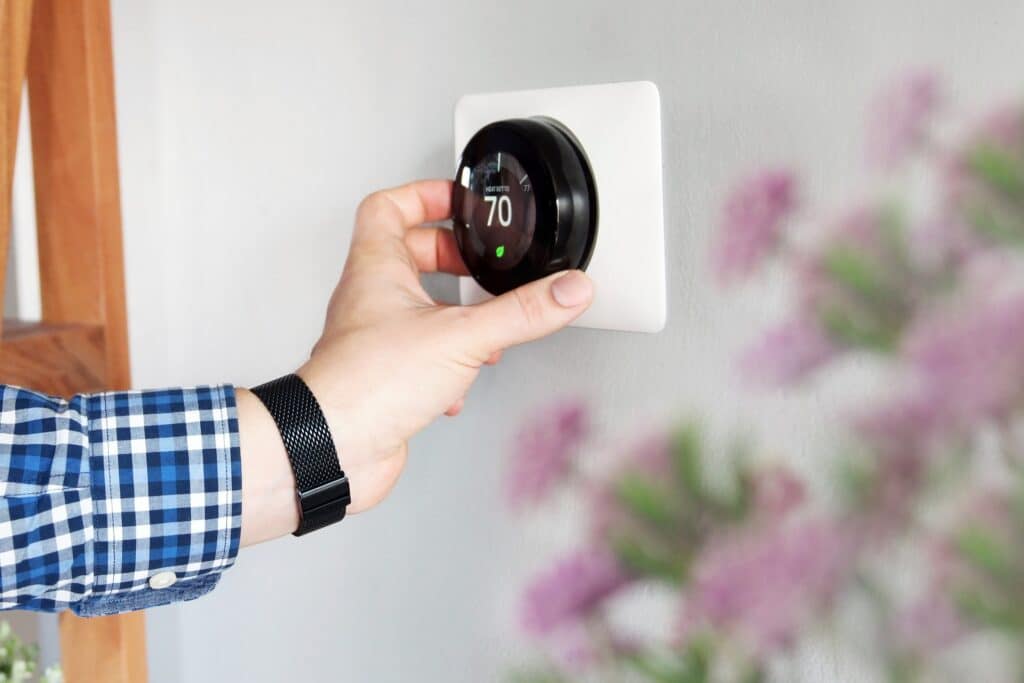
Perfect Winter Thermostat Settings for Comfort and Savings
What are the ideal thermostat settings for staying warm while saving money this winter? In Azle and Bartonville, TX, fluctuating temperatures make energy efficiency essential. Setting your thermostat too high increases costs, while too low reduces comfort. Finding the right balance keeps your home cozy without unnecessary expenses. Adjusting thermostat settings properly ensures warmth, efficiency, and lower energy bills all season long.
Ideal Thermostat Settings for Winter Days
Finding the perfect thermostat settings for winter can mean the difference between a comfortable home and skyrocketing energy bills. In Azle and Bartonville, TX, temperatures can fluctuate, making it essential to strike the right balance. The U.S. Department of Energy recommends setting your thermostat to 68°F during the day when you are home. This temperature keeps you warm while reducing unnecessary energy consumption. If it feels chilly, layering up and using sunlight to naturally warm your home can help.
For even better efficiency, consider a programmable or smart thermostat that automatically adjusts temperatures throughout the day. Lowering the setting by a few degrees when you are at work or running errands prevents energy waste. A smart thermostat can learn your schedule, making precise adjustments to keep your home cozy when needed. Avoiding frequent manual changes also prevents your HVAC system from overworking, extending its lifespan.
Insulation and air sealing play a huge role in maintaining ideal thermostat settings. Drafts around windows and doors force your heater to work harder, increasing costs. Proper insulation keeps warm air inside, maximizing efficiency. By setting your thermostat wisely and improving insulation, you can enjoy a warm, energy-efficient home all winter long.
Nighttime Thermostat Adjustments for Better Sleep
Making the right thermostat settings adjustments at night can improve sleep quality while reducing heating costs. Experts recommend setting your thermostat between 60°F and 67°F for optimal rest. Cooler temperatures help your body produce melatonin, the hormone responsible for deep sleep. Keeping your room slightly chilly prevents overheating, reducing sleep disturbances. A small nighttime temperature adjustment can lead to better sleep and noticeable energy savings.
-
Set Your Thermostat Between 60°F and 67°F
Most people sleep best in cooler environments, and keeping your bedroom within this range enhances comfort. Adjusting your thermostat settings before bed ensures a consistent temperature throughout the night. If 60°F feels too cold, start at 65°F and lower it gradually to find your ideal setting.
-
Use Warm Bedding Instead of Raising the Thermostat
Instead of increasing thermostat settings, layer up with warm blankets, flannel sheets, or thermal sleepwear. A heated blanket or mattress pad provides targeted warmth without heating the entire house.
-
Program Your Thermostat for Automatic Adjustments
A programmable thermostat allows you to set lower temperatures at night and have them rise before waking up. This simple change optimizes both comfort and efficiency.
-
Improve Insulation and Humidity for a Warmer Feel
Sealing drafts and using a humidifier prevents heat loss, helping lower thermostat settings feel more comfortable. Proper insulation reduces energy waste, maximizing your heating efficiency.
By following these nighttime thermostat settings strategies, you can sleep soundly while keeping heating costs low all winter.

The Benefits of a Programmable Thermostat
Upgrading to a programmable thermostat is a simple yet effective way to optimize thermostat settings for comfort and energy savings. Unlike manual adjustments, these devices automatically regulate your home’s temperature based on a preset schedule. This reduces energy waste while ensuring your home stays warm when needed. With smart temperature control, you can maintain a cozy environment without constantly adjusting the thermostat.
-
Save Up to 10% on Energy Bills
A programmable thermostat helps lower energy consumption by adjusting thermostat settings efficiently. The U.S. Department of Energy estimates that reducing your thermostat by 7-10°F for eight hours daily can cut heating costs by up to 10% annually. This simple adjustment translates into noticeable savings over time.
-
Maintain Consistent Comfort Levels
With a programmable thermostat, your home’s temperature stays consistent throughout the day. Instead of experiencing sudden temperature changes, you can schedule thermostat settings to gradually adjust. This ensures you wake up to a warm home and return from work to a comfortable environment.
-
Enjoy Smart Features and Remote Access
Many programmable thermostats come with Wi-Fi capabilities, allowing remote access through smartphone apps. Some models learn your habits and automatically adjust thermostat settings for maximum efficiency. These smart features offer convenience and additional energy savings.
-
Reduce Wear and Tear on Your HVAC System
Frequent temperature changes force your heating system to work harder, increasing wear and tear. A programmable thermostat minimizes sudden shifts in thermostat settings, extending the lifespan of your HVAC system.
With automated temperature control, you can enjoy a comfortable home, lower energy costs, and a more efficient heating system all winter long.
Common Mistakes to Avoid with Thermostat Settings
Proper thermostat settings keep your home comfortable while minimizing energy waste, but small mistakes can lead to higher bills and inconsistent heating. Many homeowners unknowingly overwork their HVAC systems by mismanaging temperature adjustments. Avoiding these common errors helps maintain efficiency, reduce energy costs, and extend the lifespan of your heating system.
-
Constantly Adjusting the Thermostat
Frequently changing thermostat settings forces your HVAC system to work harder, leading to increased energy use. Many believe raising the temperature heats a home faster, but most systems distribute heat at a steady rate. Instead of constant adjustments, set a consistent temperature that aligns with your routine to prevent energy waste.
-
Setting the Thermostat Too High
Turning the thermostat up to 75°F or higher won’t warm your home any faster. Instead, it causes your system to run longer, increasing energy costs. Keeping thermostat settings around 68°F during the day strikes the right balance between warmth and efficiency. If you feel cold, try layering clothing or using blankets.
-
Forgetting to Lower the Temperature at Night
Lowering thermostat settings to 60-67°F at night improves sleep quality and reduces heating expenses. Sleeping in cooler conditions prevents overheating and promotes better rest. A programmable thermostat can automate these adjustments, ensuring efficiency without sacrificing comfort.
-
Ignoring Insulation and Air Leaks
Even with proper thermostat settings, poor insulation forces your heating system to work harder. Sealing air leaks around windows and doors prevents heat loss, maintaining consistent indoor temperatures and improving efficiency.
By avoiding these common mistakes, you can optimize thermostat settings, enhance comfort, and keep energy costs under control throughout the winter.
How Humidity Affects Winter Comfort
Most homeowners focus on thermostat settings to stay warm in winter, but humidity plays a crucial role in overall comfort. Dry air makes temperatures feel colder than they are, leading to higher energy use and unnecessary thermostat adjustments. Without proper humidity control, your heating system works harder, increasing costs while still leaving you feeling chilly. Understanding how humidity affects warmth helps create a cozier, more energy-efficient home.
-
Low Humidity Makes Your Home Feel Colder
When indoor humidity drops below 30%, the air pulls moisture from your skin, making you feel colder even at normal thermostat settings. This often causes homeowners to raise the heat, leading to higher energy bills without real comfort improvements. Keeping humidity levels between 30-50% helps retain warmth, making 68°F feel much cozier.
-
Dry Air Increases Heating Costs
If your home lacks moisture, you might keep increasing thermostat settings, thinking more heat will solve the problem. However, dry air makes heat less effective, forcing your system to work harder. Using a humidifier restores moisture levels, allowing you to feel warmer at lower temperatures and reducing heating expenses.
-
Balanced Humidity Improves Health and Home Protection
Low humidity does not just affect comfort—it also causes dry skin, irritated sinuses, and static electricity. It can even damage wooden furniture and flooring by causing cracks. Proper moisture levels improve air quality, protect your home, and prevent costly repairs.
Maintaining the right humidity enhances thermostat settings, lowers energy waste, and keeps your home warm and comfortable throughout the winter.

Signs It’s Time for a Thermostat Upgrade
Your thermostat settings have a direct impact on home comfort and energy efficiency. An outdated or malfunctioning thermostat can cause temperature inconsistencies, rising utility bills, and unnecessary strain on your HVAC system. A modern thermostat offers better accuracy, convenience, and cost savings. Recognizing the warning signs can help you upgrade before small issues become costly problems.
-
Uneven Temperatures Throughout Your Home
Some rooms may feel too hot while others remain uncomfortably cold, signaling a thermostat that no longer regulates temperatures correctly. Inconsistent thermostat settings force your HVAC system to overwork, leading to higher energy consumption. A modern thermostat provides precise temperature control, ensuring even heating and a consistently comfortable indoor environment.
-
Rising Energy Bills Without Explanation
Higher heating costs without any major usage changes often indicate thermostat inefficiency. Older models struggle to read temperatures accurately, causing your system to run longer than necessary. Upgrading to a smart thermostat optimizes thermostat settings, automatically adjusting temperatures to reduce energy waste and lower monthly expenses.
-
Delayed or Unresponsive Controls
Adjusting the thermostat should lead to immediate system responses. A malfunctioning device may result in delayed heating, erratic temperature shifts, or frequent short cycling—where the system turns on and off repeatedly. Installing a new thermostat ensures accurate thermostat settings, preventing HVAC strain and improving overall efficiency.
-
Lack of Programmable or Smart Features
Older thermostats require constant manual adjustments, making it difficult to maintain efficient thermostat settings throughout the day. Newer models offer programmable schedules, remote temperature control, and energy-saving automation. Smart thermostats even learn your habits, adjusting settings for maximum comfort and efficiency.
Upgrading your thermostat enhances comfort, lowers energy waste, and ensures better heating performance throughout the winter season.
Professional HVAC Maintenance for Optimal Efficiency
Keeping your heating system in top shape requires more than just adjusting thermostat settings. Regular maintenance ensures your HVAC system runs efficiently, reduces energy costs, and prevents unexpected breakdowns. Even the best thermostat settings won’t keep your home comfortable if your system is not functioning properly. Scheduling professional maintenance with One Hour Air Conditioning & Heating of Dallas helps improve performance and extend the lifespan of your HVAC unit.
Improve Energy Efficiency and Reduce Bills
Over time, dust buildup, clogged filters, and worn-out parts force your HVAC system to work harder. This inefficiency increases energy consumption, leading to higher utility bills. A professional technician from One Hour Air Conditioning & Heating of Dallas will inspect, clean, and optimize your system, ensuring it operates at peak efficiency. With a well-maintained system, your thermostat settings can effectively regulate indoor temperatures without unnecessary energy waste.
Prevent Costly Breakdowns
Small issues can quickly turn into expensive repairs if left unchecked. Routine maintenance helps identify and fix potential problems before they cause a system failure. When your heating system is properly maintained, it responds more accurately to thermostat settings, preventing sudden malfunctions when you need warmth the most.
Extend Your HVAC System’s Lifespan
Neglecting maintenance can lead to premature wear and tear, shortening your system’s lifespan. A well-maintained HVAC unit runs smoothly, ensuring consistent thermostat settings and reliable performance for years. Investing in regular checkups reduces the risk of costly replacements down the road.
Enhance Indoor Air Quality and Comfort
Dirty air filters and ducts circulate dust, allergens, and pollutants throughout your home. Professional maintenance includes filter replacements and duct cleaning, improving indoor air quality. A clean, efficient system works better with thermostat settings, maintaining a healthier and more comfortable living environment.
By scheduling regular HVAC maintenance with One Hour Air Conditioning & Heating of Dallas, you ensure reliable heating, lower energy costs, and a more efficient system throughout the winter season.
The Role of Zoning Systems in Temperature Control
Efficiently managing indoor temperatures requires more than just adjusting thermostat settings. Traditional heating systems heat the entire home at once, often resulting in uneven temperatures and wasted energy. A zoning system divides your home into separate temperature zones, allowing customized comfort while improving efficiency. With a properly installed zoning system, you can maintain ideal temperatures in different areas while reducing energy waste.
-
Customized Comfort for Every Room
A zoning system allows you to set different temperatures in various rooms, ensuring everyone stays comfortable. If one person prefers a warmer bedroom while another likes a cooler space, separate thermostat settings make it possible. This eliminates temperature inconsistencies, preventing hot and cold spots throughout your home.
-
Increased Energy Efficiency and Lower Utility Bills
Heating or cooling the entire house at once leads to unnecessary energy use, especially in unoccupied rooms. A zoning system directs conditioned air only where it is needed, reducing waste. By optimizing thermostat settings for each zone, you improve energy efficiency and lower monthly utility costs without sacrificing comfort.
-
Reduced Strain on Your HVAC System
Traditional heating systems often work harder than necessary to regulate temperatures across the home. A zoning system balances airflow more effectively, reducing wear and tear on your HVAC unit. With better thermostat settings in each zone, your system runs more efficiently, extending its lifespan.
-
Smart Thermostat Integration for Maximum Control
Modern zoning systems integrate with smart thermostats, allowing remote temperature control through a smartphone app. This feature lets you adjust thermostat settings based on occupancy and usage patterns, maximizing comfort and energy savings.
Upgrading to a zoning system ensures better temperature control, increased energy efficiency, and personalized comfort in every part of your home.
Contact Us Today for Expert HVAC Services
Are your thermostat settings keeping your home warm and energy-efficient this winter? An outdated thermostat or struggling HVAC system can lead to higher energy bills, uneven temperatures, and costly repairs. At One Hour Air Conditioning & Heating of Dallas, we provide expert solutions to optimize your home’s comfort and efficiency.
If your thermostat fails to maintain the right temperature, upgrading to a smart or programmable model can make a big difference. Modern thermostats automatically adjust thermostat settings, reducing energy waste while keeping your home consistently comfortable. Our skilled technicians will help you choose and install the best option for your needs.
Routine HVAC maintenance is just as important. A professional tune-up ensures your system runs efficiently, prevents unexpected breakdowns, and helps your thermostat settings work effectively. Scheduling service with One Hour Air Conditioning & Heating of Dallas means reliable warmth, lower utility bills, and long-term savings.
Take control of your home’s comfort with expert heating services. Call One Hour Air Conditioning & Heating of Dallas today for professional maintenance, thermostat upgrades, and energy-efficient solutions!
FAQS
-
What is the ideal winter thermostat setting for comfort and energy savings?
The U.S. Department of Energy recommends setting your thermostat to 68°F while you are home and awake for the best balance of comfort and efficiency. Lowering the temperature to 60-67°F while sleeping or away can help reduce heating costs without sacrificing warmth.
-
Can lowering thermostat settings really save money on energy bills?
Yes! Reducing your thermostat settings by 7-10°F for at least eight hours a day can lower your heating bills by up to 10% annually. Using a programmable or smart thermostat helps automate these changes for maximum savings.
-
Should I turn my thermostat off when leaving home for extended periods?
No, turning your heating system off completely can cause indoor temperatures to drop too low, increasing the risk of frozen pipes. Instead, set your thermostat to 55-60°F to maintain efficiency and prevent damage while you are away.
-
Will a smart thermostat improve winter heating efficiency?
Absolutely! Smart thermostats learn your schedule and adjust thermostat settings automatically, ensuring comfort while minimizing energy waste. Many models also allow remote access, so you can control temperatures from anywhere using a smartphone app.
-
How can I make my home feel warmer without raising the thermostat?
Improve insulation, seal drafts around doors and windows, and use a humidifier to maintain indoor humidity levels between 30-50%. These steps help your home retain heat better, making 68°F feel much cozier without increasing energy costs.
Optimizing your thermostat settings ensures comfort and efficiency all season long. For expert HVAC services in Azle and Bartonville, TX, contact One Hour Air Conditioning & Heating of Dallas today for reliable heating solutions and professional assistance!






